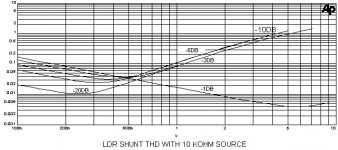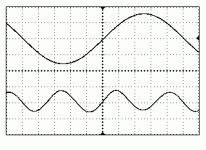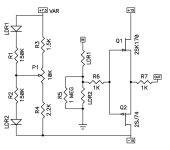> I forgot to mention that because I have not followed the entire
>thread, it is possible that I have duplicated something without
> knowing it. If that's the case then
> Excuuuuuuuse Meeeeee!
No no. This is great.
At last someone publish some independent data based on actual measurements, rather than just posting figures from the manufacturer.
Thanks for that,
Patrick
>thread, it is possible that I have duplicated something without
> knowing it. If that's the case then
> Excuuuuuuuse Meeeeee!
No no. This is great.
At last someone publish some independent data based on actual measurements, rather than just posting figures from the manufacturer.
Thanks for that,
Patrick
EUVL said:I wonder if you would kindly measure the distortion using a fixed series resistor (say a Dale 10k) and only one LDR as shunt. From 0-40dB would be great.
I have shown the figures for 600 ohm resistance, but when I have
a chance I'll take a look.
> I have shown the figures for 600 ohm resistance, but when I have a chance I'll take a look.
I meant replacing LDR1 in your schematics with a 10k fixed R.
There are too many claims in the thread that 2xLDRs (one series and one shunt) is better (has less distortion) than one fixed R and one LDR. It would be great to see some measurement data from an independent source.
Patrick
I meant replacing LDR1 in your schematics with a 10k fixed R.
There are too many claims in the thread that 2xLDRs (one series and one shunt) is better (has less distortion) than one fixed R and one LDR. It would be great to see some measurement data from an independent source.
Patrick
Here you go. Keep in mind that the figures are a little misleading
if you don't remember that with larger attenuation, the probability
that you will be seeing the higher output voltages is quite low.
Also, ignore the noise at low levels on the -1 dB curve - the impedances
are high, and the circuit unshielded.
Also Also, it is not feasible to get more than about 35 dB attenuation
with this circuit.
if you don't remember that with larger attenuation, the probability
that you will be seeing the higher output voltages is quite low.
Also, ignore the noise at low levels on the -1 dB curve - the impedances
are high, and the circuit unshielded.
Also Also, it is not feasible to get more than about 35 dB attenuation
with this circuit.
Attachments
EUVL said:Can you perhaps describe the sonic difference between expansive and compressive distortions ?
With pleasure. The distortion is 3rd harmonic, and when you look
at the distortion wave juxtaposed against the original sine wave,
you will see that the peaks and troughs are lining up with the peaks
of the signal peaks.
When you look the positive signal peak and see that at the same
time the distortion is also enjoying a positive peak, and similarly
when the negative signal is lined up with a negative peak on the
distortion, that means that the signal is distorted to make the
peaks larger - this would be expansive.
Seen more commonly, when the signal peaks line up with distortion
peaks of the opposite phase, this means that the distortion is
making the peaks of the original signal slightly smaller. This is
compressive.
Here is an example of this on a scope trace. In this example the
distortion is compressive. If you inverted the phase of the distortion
waveform it would be expansive.
Attachments
Nelson Pass said:I chose the NSL32SR3 for its better matching, linearity, and range,
and created attached circuit.
The values of R1 and R2 were chosen to make the summation of
the resistors of LDR1 and LDR2 equal to 10K ohm, which then sets
the minimum input impedance of the circuit with the rail voltages
you have (in this case the commonly found +/-15V).
Then you attach the potentiometer with the values shown with the
bottom end going to the -15V rail and the top to a variable regulator.
The nominal value of this regulator is 7.5V, but it needs to be
adjustable so that you get the range you want.
The range that this was adjusted for was -1 dB at the top and
-40 dB at the bottom. More range is possible, but at the expense
of the taper characteristic.
The buffer section consists of matched 2SK170 and 2SJ74, matched
for Idss. If you do not have matched parts and DC offset is an
issue, then consider using an output coupling cap.
The bandwidth of the active buffer is extremely wide, and for that
reason 1K ohm input and output resistors are appropriate.
The distortion of the active buffer is about .003% on a clear day
at 1 V, which is less than you will be experiencing with the LDR
portion of the circuit.
Of course you can tart this up as you like - I consider this the
minimal circuit.
Good morning Hal, my god, you have been busy, I say many thanks for everyone on this thread.
I have a friend who uses almost the identical of this circuit for his Series Shunt Lightspeed also.
Have you posted it once before somewhere?
He uses battery supply, 2 X 12v in series center tap to ground and positive rail also goes to the variable regulator, loves the sound he gets, but when possible with other high impedance amps, he still just prefers the unassisted series shunt Lightspeed, says it's more natural sounding.
Cheers George and once again many thanks.
EUVL said:But I wonder how the human ear interprets that -- expansive = brighter sound ??
Good question for which I do not have an answer. I expect that
the effect is reasonably subtle.
EUVL said:Perhaps you would share with us your subjective impression of LDRs compared to other attenuators you have built / used to date ??
Yes please!
- Home
- Source & Line
- Analog Line Level
- Lightspeed Attenuator a new passive preamp



